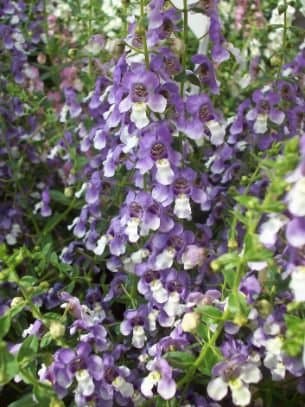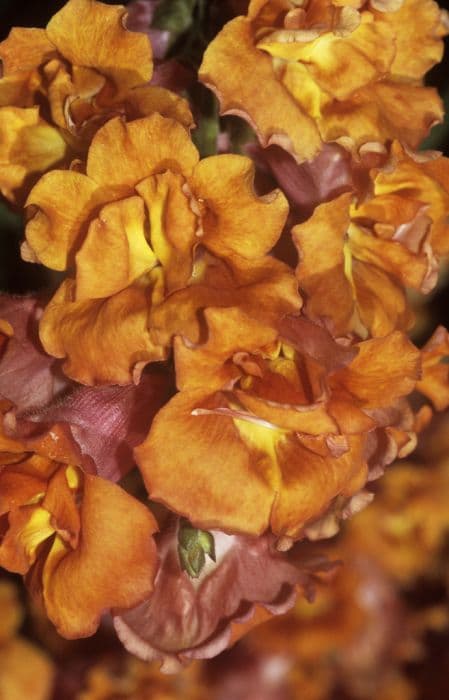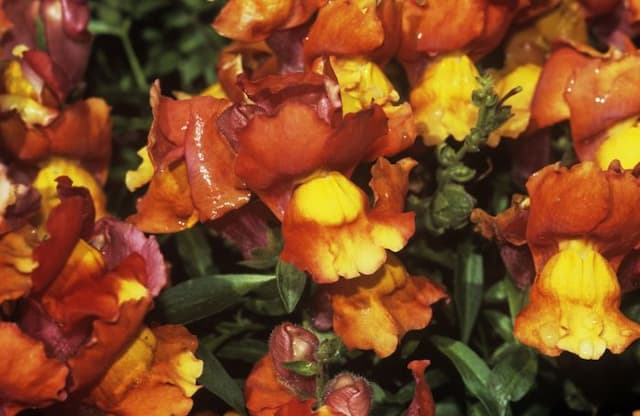Foxglove Digitalis purpurea

ABOUT
Digitalis purpurea, commonly known as the foxglove, is a strikingly beautiful plant that is easily recognizable by its tall spike of bell-shaped flowers. These flowers come in a variety of colors, including shades of pink, purple, white and yellow, each adorned with unique interior speckling. The blooms hang gracefully downward and are arranged around the stem in a close, overlapping pattern. The leaves of the foxglove are equally distinctive. They are large, simple, and oval-shaped with a slightly toothed margin, providing a lush green backdrop to the colorful flowers. As they are not uniform in size, the lower leaves tend to be the largest, forming a rosette at the base, while they become gradually smaller up the stem. Overall, the foxglove’s foliage is covered with fine hairs that give it a soft, downy texture to the touch. This plant thrives particularly well in environments that mimic its native woodland habitat, often found embellishing shady forest floors, and giving the impression of towering floral columns within a green landscape.
About this plant
 Names
NamesFamily
Plantaginaceae.
Synonyms
Common Foxglove, Purple Foxglove, Lady's Glove, Fairy Fingers, Fairy Petticoats, Witches' Gloves, Dead Men's Bells, Folk's Glove, Virgin's Glove, Fairy Thimbles, Fairy Caps, Fairy Herb, Lion's Mouth, Throatwort, Scottish Thimbleflower, Bloody Fingers, Bloody Bells, Dead Man's Thimble.
Common names
Digitalis purpurea L.
 Toxicity
ToxicityTo humans
Foxglove is highly toxic to humans if ingested. It contains cardiac glycosides, particularly digitoxin and digoxin, which can cause severe poisoning. Symptoms include nausea, vomiting, diarrhea, abdominal pain, confusion, weakness, vision changes such as seeing halos or blurriness, and potentially life-threatening heart problems such as bradycardia (slow heart rate), palpitations, and cardiac arrhythmias. Ingestion can lead to severe illness or death. Medical attention should be sought immediately if ingestion is suspected.
To pets
Foxglove is also highly toxic to pets, including dogs, cats, and horses. Like in humans, the cardiac glycosides in the plant can cause severe poisoning in animals. Symptoms of poisoning in pets may include vomiting, diarrhea, drooling, abdominal pain, cardiac arrhythmias, weakness, depression, seizures, and possibly death. Any consumption of this plant by pets should be treated as an emergency, and immediate veterinary care is required.
 Characteristics
CharacteristicsLife cycle
Biennials
Foliage type
Deciduous
Color of leaves
Green
Flower color
Pink
Height
2-5 feet (0.6-1.5 meters)
Spread
1-2 feet (0.3-0.6 meters)
Plant type
Herb
Hardiness zones
4
Native area
Europe
Benefits
 General Benefits
General Benefits- Attracts Pollinators: Foxglove is known to attract bees, butterflies, and hummingbirds, enhancing pollination in the garden.
- Ornamental Value: Foxglove produces tall spikes of tubular flowers in a variety of colors, adding aesthetic appeal to landscaping and gardens.
- Wildlife Habitat: Provides shelter and food for wildlife, particularly invertebrates that feed on its nectar.
- Soil Improvement: Foxglove can grow in poor soil and, as it decomposes, can contribute to soil enrichment and structure.
- Companion Planting: Can be planted alongside other garden plants to create a diverse environment that supports a variety of insects and birds.
 Medical Properties
Medical Properties- Cardiac glycosides: Digitalis purpurea, commonly known as foxglove, contains cardiac glycosides that can improve heart contractility and manage some heart conditions.
- Heart failure treatment: The active compounds, including digoxin and digitoxin, have been used to treat certain types of heart failure by increasing the force of heart muscle contractions.
- Atrial fibrillation management: Foxglove derivatives can be used to manage atrial fibrillation, a common type of irregular heartbeat.
- Regulation of heart rate: The plant's extracts have properties that can help regulate heart rate in patients with certain cardiac disorders.
 Air-purifying Qualities
Air-purifying QualitiesThis plant is not specifically known for air purifying qualities.
 Other Uses
Other Uses- Dye: The leaves, flowers, and seed of the Digitalis purpurea, commonly known as Foxglove, can be used to make natural dyes, often producing colors such as green and yellow.
- Gardening: Foxglove is valued by gardeners for its striking, bell-shaped flowers and its ability to attract pollinators such as bees, hummingbirds, and butterflies to the garden.
- Photography: Foxglove's tall, colorful spires make it a popular subject for photographers and plant enthusiasts seeking to capture the beauty of native wildflowers.
- Education: Foxglove can be used in educational settings to teach about plant reproduction, particularly how bees pollinate flowers.
- Companion Planting: Foxglove is sometimes used in companion planting to draw aphids and other pests away from more vulnerable plants that are also a part of the garden.
- Environmental Indication: Due to its preference for slightly acidic soil, the presence of Foxglove in the wild can indicate soil conditions that may affect the growth of other plants.
- Folk Art Materials: The dried seed pods and stalks of Foxglove can be incorporated into folk art and crafts for their unique shapes and textures.
- Fauna Habitat: Foxglove provides a habitat and food source for caterpillars and other insects, which in turn support local ecosystems.
- Erosion Control: Given its propensity to grow in a wide range of conditions, Foxglove can be used in certain areas to help stabilize soil and prevent erosion.
- Feng Shui: In certain cultures, Foxglove is planted for its purported ability to bring positive energy to a garden space as per Feng Shui principles.
Interesting Facts
 Feng Shui
Feng ShuiThe Foxglove is not used in Feng Shui practice.
 Zodiac Sign Compitability
Zodiac Sign CompitabilityThe Foxglove is not used in astrology practice.
 Plant Symbolism
Plant Symbolism- Healing: Digitalis purpurea, commonly known as Foxglove, has been used medicinally for heart conditions, symbolizing its capacity to heal.
- Bewitchment: The enchanting appearance of Foxglove's blooms often associates it with magic and folklore, symbolizing bewitchment or allure.
- Inspiration: Its towering spires of bell-shaped flowers can inspire artistic and creative thoughts.
- Insincerity: In the Victorian language of flowers, Foxglove sometimes represented insincerity, possibly due to its toxic properties despite its beautiful appearance.
- Protection: Foxglove folklore suggests it can ward off evil influences, symbolizing protection.
 Water
WaterFoxglove requires consistent moisture, especially during its growing season in spring and early summer. Water the plant deeply once a week, providing about 1-2 inches of water each time to ensure the soil is moist but not waterlogged. During hotter, drier weeks, you may need to water twice a week, depending on the soil and weather conditions. Reduce watering in the fall and winter when the plant is dormant. It is best to avoid overhead watering to prevent leaf spot diseases; instead, water at the base of the plant, directing the water to the roots where it is most needed.
 Light
LightFoxglove thrives in partial shade, especially in areas with hot summers. The ideal spot would offer morning sun and afternoon shade, or dappled light beneath open trees. They can also tolerate full sun in cooler climates, but the soil must remain consistently moist to prevent stress.
 Temperature
TemperatureFoxglove prefers moderate temperature conditions and can survive in temperatures ranging from approximately 40 to 80 degrees Fahrenheit. The ideal temperature for optimal growth tends to be between 50 and 70 degrees Fahrenheit. While the plant can endure brief periods outside of this range, extreme heat or frost can be harmful.
 Pruning
PruningPrune foxglove to promote further growth and maintain a tidy appearance. After the main spike has finished flowering, cut it back to encourage side shoots and a second bloom. Pruning is typically done after the first flush of blooms in early to mid-summer. Deadheading, or removing spent flowers, can also prevent the plant from self-seeding excessively.
 Cleaning
CleaningAs needed
 Soil
SoilFoxglove prefers a well-draining soil mix rich in organic matter with a slightly acidic to neutral pH of 5.5 to 7.0. Amend garden soil with compost and peat moss to enhance texture and nutrient content for optimal growth.
 Repotting
RepottingFoxgloves are biennials and typically do not require repotting as they are often grown from seed and will only live for two years, flowering in their second year before dying.
 Humidity & Misting
Humidity & MistingFoxglove thrives in average outdoor humidity levels; it does not require any special humidity adjustments and does well in the natural fluctuating outside humidity conditions.
 Suitable locations
Suitable locationsIndoor
Provide bright indirect light, cool temps, and moist soil.
Outdoor
Plant in partial shade to sun, in rich, moist soil.
Hardiness zone
4-9 USDA
 Life cycle
Life cycleThe life of foxglove (Digitalis purpurea) begins as a seed, which upon germination gives rise to a rosette of leaves in its first year, growing at ground level. During its second year, the plant develops a tall spike with tubular pink-purple flowers that are spotted inside and are arranged in a one-sided raceme, attracting various pollinators such as bees. After pollination, the flowers develop into seed capsules, which then dry and split open to release numerous tiny seeds. These seeds disperse by wind, water, or animals, and upon finding suitable conditions, they germinate to continue the cycle. Foxglove is a biennial plant, meaning that it typically completes its life cycle within two years, dying after producing seeds. However, if conditions are favorable, some plants may behave as short-lived perennials, producing flowers for more than one season.
 Propogation
PropogationPropogation time
Spring-Early Summer
Foxglove (Digitalis purpurea) is commonly propagated through seed sowing. The best time to sow foxglove seeds is late spring to early summer or soon after the seed matures. For successful germination, scatter the seeds on the surface of a well-draining soil mix and lightly press them into the soil, but do not cover them as they require light to germinate. Keep the soil moist but not waterlogged. Germination can take anywhere between 2 to 4 weeks. Seedlings can be transplanted into the garden once they have a couple of true leaves and the risk of frost has passed. It's important to space the plants about 12 to 24 inches (approximately 30 to 60 cm) apart to ensure adequate air circulation and room for growth.









